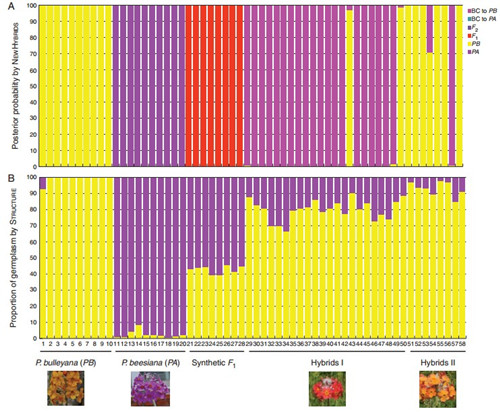Heteromorphy in flowers has a profound effect on breeding patterns within a species, but little is known about how it affects reproductive barriers between species. The heterostylous genus Primula is very diverse in the Himalaya region, but hybrids there have been little researched.
Chloroplast sequencing, AFLP (amplified fragment length polymorphism) markers and morphological comparisons were employed to characterize putative hybrids in the field, using synthetic F1s from hand pollination as controls. Pollinator visits to parent species and hybrids were observed in the field. Hand pollinations were con-ducted to compare pollen tube growth, seed production and seed viability for crosses involving different morphs, species and directions of crossing.
Molecular data revealed all hybrid derivatives examined to be backcrosses of first or later generations towards P. bulleyana: all had the chloroplast DNA (cpDNA) of this species. Some individuals had morphological traits suggesting they were hybrids, but they were genetically similar to P. bulleyana; they might have been advanced generation backcrosses. Viable F1s could not be produced with P. bulleyana pollen on P. beesiana females, irrespective of the flower morphs used. Within-morph crosses for each species had very low (10 %) seed viability, whereas crosses between pin P. bulleyana (female) and pin P. beesiana had a higher seed viability of 30 %. Thus genetic in-compatibility mechanisms back up mechanical barriers to within-morph crosses in each species, but are not the same between the two species. The two species share their main pollinators, and pollinators were observed to fly between P. bulleyana and hybrids, suggesting that pollinator behaviour may not be an important isolating factor.
Hybridization is strongly asymmetric, with P. bulleyana the only possible mother and all detected hybrids being backcrosses in this direction. Partial ecological isolation and inhibition of heterospecific pollen, and possibly complete barriers to F1 formation on P. beesiana, may be enough to make F1 formation very rare in these species. Therefore, with no F1detected, this hybrid zone may have a finite life span as successive generations become more similar to P. bulleyana.
This paper was published in Annals of Botany on 2 February, 2014, entitled “Unidirectional hybridization and reproductive barriers between two heterostylous primrose species in north-west Yunnan, China” (http://aob.oxfordjournals.org/content/early/2014/02/02/aob.mct312.full?keytype=ref&ijkey=kxeONI1tQZj1QZS).

Shared pollinators among parental species and putative hybrids.
Aporia bieti visiting P. bulleyana (A), a putative hybrid (B) and P. beesiana(C). Anthophora sp. visiting P. bulleyana (D), a putative hybrid (E) and P. beesiana (F). Scale bar = 2 cm.

Genotype class assignment of all individuals based on the programs NEWHYBRIDS(A) and STRUCTURE(B) using molecular data.




